Are you a brand trying to excel in influencer marketing or an aspiring influencer looking to make a significant income? Do you find it challenging to decide which platform to go for? Well, we‘ll unlock the full potential of TikTok vs. Instagram!
In the fast-changing world of social media, two platforms stand out for their significant impact online: Instagram vs. TikTok. Aspiring influencers are eager to capture audiences and make a name for themselves in the digital world and the brands seeking TikTok or Instagram influencer marketing. But the big question is, which platform is the best for achieving success? Don’t worry, we’ve got you covered with a detailed guide that compares TikTok and Instagram.
This article will give you the information you need to decide which one suits you best on your path to becoming an influencer. Then, we will delve into the demographics and user behavior on both platforms, uncover the types of content on each, and examine the monetization opportunities available to influencers.
Now, let’s get started!
TikTok vs. Instagram: Users + Pros & Cons
Firstly, we’ll find out what they are, and then we can talk about the differences between Instagram and TikTok!
Instagram is a powerful marketing tool that supports various marketing approaches, such as affiliate marketing and influencer marketing. To succeed on Instagram, providing top-quality content that educates and excites the audience about their interests is crucial. Utilizing hashtags for Instagram Reels and content posts can help reach the right audience effectively.
Micro-influencers have emerged as a fascinating trend on Instagram. So, collaborating with micro-influencers allows brands to reach a highly interested and dedicated group of users, rather than targeting a massive, generic audience.
Read Also: Best Ways To Find Micro Influencer To Grow Your Brand
How Many Users Are Active on Instagram?
In 2021, about 1.21 billion people used Meta’s Instagram every month, which was more than a quarter (28 percent) of all internet users worldwide. It’s predicted that by 2025, the number of monthly users will grow to 1.44 billion, making up around 31.2 percent of internet users globally.
Instagram has a diverse audience, with 25-34-year-old men being the most active users, followed closely by women in the same age group. But it’s not just limited to them; people of all ages use Instagram, making it a popular and exciting platform for everyone. No wonder it’s loved by so many!
Read Also: Affiliate Marketing Vs Influencer Marketing – The Ultimate Guide
Instagram Pros and Cons
This social media platform offers many great reasons to join in, but like any app, there are a couple of important things to remember.
Instagram Pros
Let’s start with Instagram pros:
- Lots of Variety: Instagram has various content types like classic feeds, entertaining reels, and captivating stories. This makes it a fantastic place for advertising opportunities. You can reach your audience in different ways and stand out!
- Global Audience: Instagram has an enormous user base of two billion people from around the world. This means you can connect with all kinds of people from different backgrounds.
- User-Friendly Ads: The best thing about Instagram ads is that they smoothly blend into users’ feeds. No annoying pop-ups, just a seamless experience for users.
- Versatile Content Sharing: Instagram makes cross-platform content sharing easy, allowing users to share various types of content, such as short videos (Reels), temporary moments (Stories), and longer videos (IGTV + Live). This versatility enables users to engage their audience in different ways and cater to varying preferences.
- Diverse Video Options: With four different video formats (Instagram Reels, In-Feed Videos, Instagram Stories, and Instagram Live) available, Instagram offers flexibility in video content creation. Each format comes with its advantages and limitations, empowering users to choose the most suitable option to convey their message effectively.
Instagram Cons
Of course, there are a couple of cons to consider:
- Timing Matters: To make an impact and get noticed, it’s essential to know when your audience is most active. Figure out the best times to post your content for maximum visibility.
- Be Consistent: On Instagram, posting regularly is crucial. Keep your audience engaged by posting at a steady pace. Consistency helps you stay relevant and memorable.
- Overwhelming Advertisements: The platform is flooded with numerous advertisements and sponsored posts, which can be quite intrusive and annoying for users.
- No ability to add photos to an existing Instagram post: Unlike some other social media platforms, Instagram does not allow users to directly add new photos to a post that has already been published.
- Technical Drawbacks: Instagram suffers from various technical issues, including subpar web optimization, image display problems, limited privacy settings, and inadequate tech support.
- Absence of post-editing: Once an Instagram post is published, there is no built-in feature to edit the content.
- Unfollow Limitation: Instagram imposes a strict unfollow limit of 60 accounts per hour and 150 accounts per day. Mass unfollowing can lead to temporary account access loss.
- Like Limitation: Liking posts from accounts you don’t follow may increase the risk of being banned. Following a best practice of liking only three last posts of each new account, resulting in 300-400 likes per day, is recommended.
- Comment Limitation: Instagram has become stricter with commenting, especially on posts from unfamiliar accounts. Users should start with 3-5 comments per day and not exceed a maximum of 30 comments daily.
- Direct Message Limits: The limit for sending direct messages (DMs) is also set at 30 per day. However, users must avoid sending the same message to multiple accounts and should personalize their messages for better results.
In summary, Instagram offers great opportunities for advertisers. But remember, understanding your audience and staying consistent are the keys to success on this vibrant social media platform. So, be creative, stay on track, and watch your success!
TikTok
It is a platform known for its captivating and creative short videos. Marketing on TikTok involves promoting a brand, product, or service through various strategies, including influencer marketing, TikTok advertising, and creating content that can go viral naturally.
Some of the benefits businesses can gain from TikTok marketing include boosting brand awareness, building engaged communities, increasing sales, gathering feedback, providing customer service, and targeting specific audiences through advertising.
Let’s see:
How Many Users Are Active on TikTok?
Around the world, there are 4.8 billion people using the internet, and approximately one-fifth of them (20.83%) are on TikTok. In 2022, TikTok had about 1.7 billion users worldwide, which was a huge increase of over 66 percent compared to 2020.
TikTok started in 2017 as an international version of a Chinese social media app called Douyin. It became very popular in 2020, with around 313.5 million people downloading it in the first three months of the year. Experts predict that TikTok will have about 2.25 billion users by 2027.
TikTok Pros and Cons
If you’re thinking about using TikTok for your social media plan, similar to Instagram, there are some good things and some important points to remember. Let’s look at the advantages and disadvantages:
TikTok Pros
- Easy and Fun Videos: One great thing about TikTok is that you don’t need expensive gear. Your videos can be natural and real, saving you money on lights and makeup.
- Large Audience: TikTok already has over a billion users, and it’s still growing rapidly. That means there’s a huge audience ready to discover your content.
- Flexible Posting: Unlike some platforms, you don’t have to worry about posting at the perfect time. You can even share similar videos without overwhelming your followers.
- Increase Awareness for New Brands: TikTok’s frequent display of ads introduces users to new products, promoting useful and innovative items. The platform’s TikTok store further facilitates access to these products, offering an online shopping experience.
- Great Way of Reaching Small Businesses: With a massive user base, TikTok serves as an excellent advertising platform for small businesses, enabling them to connect with their target audience.
- Educational (school/safety): TikTok is not only a source of entertainment, but also provides valuable educational content. Users can find online tutors and a diverse range of informative videos on various subjects.
TikTok Cons
- Avoid Heavy Advertising: TikTok users prefer entertaining content over ads. So, focus on creating engaging and enjoyable stuff instead of just posting ads.
- Consistency is Key: To be successful on TikTok, it’s important to be consistent. Try to post at least once a day for the first month, and some users even post two or three times daily.
- Limited Sound and Effects Choices: TikTok users are currently restricted in their ability to choose sounds, effects, and other elements due to API limitations.
- No Messaging Functionality in Business Accounts: TikTok users cannot send direct messages to other TikTok users or fans, hindering direct communication and engagement.
- No Custom Thumbnail for videos: Users are unable to add custom thumbnails to their TikTok video posts, potentially affecting the visual presentation and appeal of their content.
- No Editing or Deletion of Published Posts: Once a post is published on TikTok, users have no option to edit, which may be problematic in case of mistakes or changes in content.
- Limited Customization with Text and Stickers: API limitations prevent users from freely adding custom text and stickers to their TikTok videos, limiting creative expression and personalization options.
Now, it’s time to find out how TikTok differs from Instagram and what are their main differences! Ready? Let’s go!
TikTok vs. Instagram: What Are the Key Differences?
Instagram is older than TikTok by four years, which feels like a really long time in the world of social media. During that period, Instagram completely changed the way people share things, connect with others, interact, and how influencers promote products.
The main contrasts between these two platforms are:
- Instagram focuses on visuals like pictures, slideshows, temporary posts (Stories), short videos (Reels), longer videos (IGTV), live streaming (Live), and lists (Guides).
- TikTok is a well-known platform for vertical, short videos. The app allows users to create, share, and discover videos that are typically 15 to 60 seconds long. These videos are displayed in a vertical orientation, optimized for mobile viewing.
But there are also many small differences between TikTok and Instagram when it comes to the type of audiences they attract, the style of content, advertising, and influencer marketing on each platform.
Let’s dive into it!
1. TikTok vs. Instagram: Algorithms
TikTok algorithm is superior. Why? It has a cool “For You” page, using AI to show videos you’ll love, one at a time. Plus, you can easily switch between videos from accounts you follow and those from others. This smart approach makes people watch the entire video, leading to more impressions for content creators.
TikTok’s best part? Viral fame for anyone, no huge following needed! Share relatable, funny content, and use trends and hashtags.
Instagram’s trickier to go viral. Users must follow you to see posts if your account is private. The Instagram algorithm decides what appears in Feeds and Explore based on interests. Instagram Reels can go viral, but not as simple as TikTok.
Both platforms consider user activity (likes, comments, shares, saves), followed accounts, and keywords (captions, hashtags, locations) before boosting content on feeds.
In short, TikTok levels the playing field for virality, while Instagram leans towards bigger followings.
For a wild viral ride, go for TikTok! 😉
2. TikTok vs. Instagram: Features
Let’s start with TikTok, which has the “For You Page,” a special feed that shows you exciting content without following anyone. TikTok uses a smart AI algorithm to tailor videos just for you! On the other hand, there’s the classic Instagram, where your feed is filled with posts from people you follow, making it a more personalized experience.
TikTok is mainly focused on fun video-making and sharing, while Instagram is a more adaptable platform. Instagram not only allows you to create and share videos, but also offers additional features like Reels, IGTV, and Stories. It’s great for photos too, offering options like carousels and other cool stuff.
However, TikTok is the true champion when it comes to video tricks and editing, as it has powerful and advanced features for that.
3. TikTok vs Instagram: Users
TikTok has one billion active users every month and is loved by Gen Z, while Instagram has an impressive two billion monthly active users, mostly millennials.
Now, let’s dive into user demographics to help you find the perfect fit for your target audience.
Instagram vs. TikTok: Audience Demographics
TikTok is popular among the young and vibrant Gen Z generation. Meanwhile, Instagram has a massive user base of millennials, followed closely by Gen Z as the second largest age group.
Want to know more? We’ve got the juiciest age and gender details for TikTok and Instagram from Statista experts.
Here’s the distribution of TikTok users worldwide in 2023 by age and gender:
As you can see, TikTok remains the top favorite social platform for teenagers and young adults. Most of the app’s users are the youngest content creators you can find online today. It’s like a digital playground where the trendiest young people gather!
Now, let’s take a look at TikTok vs. Instagram Users’ behavior!
So, let’s take a look at TikTok vs Instagram content!
4. TikTok vs. Instagram: Types of Content
So, whether it’s TikTok or Instagram, you’re in for a wild ride of creative expression and connecting with people in the most fun and visually stunning ways possible! Let’s dive into the specific content types you can share on these social media platforms.
TikTok vs. Instagram Reels
Firstly, let’s take a look at the Instagram reels vs. TikTok video similarities! Ready?
- Reels and TikToks offer engaging short-form videos with looping and swipe-up features.
- Both platforms provide filters, effects, sounds, and various editing tools for video content creation.
- Instagram introduced Reels to compete with TikTok’s popular format.
Now, it’s time to see the differences:
- TikTok videos are often created within the app, while on Instagram, creators mostly reupload existing videos.
- TikToks are more spontaneous and interactive, with features like duets and debates between users, fostering more engagement.
- Instagram lacks the duet feature found on TikTok, resulting in less interaction between creators.
- TikTok’s culture revolves around challenges and trends that inspire creators, while Instagram often adopts trends from TikTok.
- Instagram Reels have a one-minute time limit, while TikToks can be up to three minutes long.
TikTok vs. Instagram Stories
TikTok and Instagram stories are quite similar. They are short posts that disappear after 24 hours, letting people see what you’ve been doing for the day. With a public account, anyone can view your story. But with a private account, only your followers can see it.
Stories are a great way to engage with others and get feedback. They are easier to create than regular posts.
The main differences are:
- On TikTok, stories appear as regular posts, while on Instagram, you must tap on profile pictures to see them.
- TikTok stories have “templates” to make dynamic videos from photos, which Instagram lacks.
TikTok vs. Instagram Lives
Let’s talk about live streaming on social media! It’s a captivating trend that lets you directly connect with your followers, making engagement easy.
Instagram, the trendy hub, is a hot spot for celebrities and influencers to go live and interact with their audience. They share their daily routines, endorse brands, host live Q&As, and give sneak peeks into their fabulous lives – behind-the-scenes, holidays, and private parties! It’s all about sparking lively discussions with their followers.
TikTok live is also loads of fun! If you’re at least 16, you can join the live-streaming bandwagon. And if you’re 18 or older, you can even receive cool gifts, including cash prizes!
Amazing, isn’t it?
5. TikTok vs. Instagram: Influencer Marketing
Instagram, with many influencers, is well-established, but TikTok is catching up with engaging features like Stitches, Duets, and Challenges. Both platforms allow influencers to add user-generated content (UGC) to their sponsored content. Instagram remains the top choice for influencer marketing, with 98% of marketers preferring it. TikTok is used by 12% of marketers for influencer campaigns.
Influencer campaigns are an effective way to reach a wider audience, build brand awareness, and boost conversions, without being too promotional.
Key differences between TikTok and Instagram influencers:
- Instagram influencers create carefully planned, aesthetic, and inspirational content, treating their online presence as a brand.
- TikTok influencers are more unconventional and often became famous unexpectedly, sharing entertainment or knowledge with their growing audience.
Therefore, TikTok influencers are generally more relatable and authentic due to the intimate nature of video sharing on the platform compared to curated images on Instagram.
Again, TikTok is superior here!
6. TikTok vs. Instagram: Advertising Options
In the world of social media marketing, Instagram is an experienced leader with a strong foundation for advertising. We know for sure that Reels are highly effective for smart marketers, bringing great results and engaging audiences like never before.
But don’t underestimate TikTok! This lively platform offers many advertising chances, from catchy In-Feed Ads to impressive Branded Effects.
7. TikTok vs. Instagram: Social Commerce
TikTok has made great progress in social commerce recently, though it’s still testing its e-commerce features. But don’t worry, it has a strong influencer community and user-friendly links for shopping.
Now, let’s talk about Instagram, the top social commerce platform! It offers many shopping features within the app and premium advertising for easy access to products and services. Instagram also has cool AR filters and swipe-ups in IG Stories.
Though TikTok is refining its ecommerce, it’s catching up to Instagram. Both platforms offer fun and creative ways to eCommerce marketing and engage with brands!
But the Big question is which platform is the best for your business?! Let’s find out!
TikTok vs. Instagram: Which One Is Better?
There is no definitive answer to which platform is the best between TikTok and Instagram for marketing. Both platforms have unique strengths and are suited for different purposes depending on your target audience and marketing goals. Here’s a summary of the key points to consider:
Choose TikTok if:
1. You want to reach a younger audience, particularly Gen Z-ers.
2. You prefer raw and authentic content.
3. You aim to become a micro-influencer and grow your brand.
4. Your main content goals are to reach more people, show off your brand personality, and go viral.
Choose Instagram if:
1. You cater to both younger and older audiences (Gen X, Millennials, and older Gen Z-ers).
2. You prefer polished content.
3. You want to use influencers with a more established online persona and polished content.
4. Your main content goals are to post product images, shoppable posts, generate leads, and redirect prospects to your website.
Additionally, consider that pairing both platforms can be a smart strategy as it allows you to hit a wider audience and increase impressions among overlapping users.
Ultimately, the best platform for your business depends on your specific target audience, marketing objectives, and the types of content you plan to create. Testing both platforms and analyzing the results will help you make an informed decision based on what works best for your brand.
With the information provided above, you now understand that each platform caters to unique audiences and content styles. If you’re looking to leverage the power of influencer marketing on both TikTok and Instagram, Read on!
Ainfluencer: The Professional Influencer Marketing Platform
Ainfluencer is an influencer marketplace that brings together a diverse array of influencers from both TikTok and Instagram, giving you the flexibility to choose the perfect match for your brand and marketing goals.
Our platform lets you connect with influencers who match your brand perfectly, whether you want to reach TikTok’s creative Gen Z audience or Instagram’s diverse users of all ages. Discover the right influencers for your brand using our filters – choose by keywords, location, hashtags, language, gender, and follower count.
Listen up Brands! Leverage Ainfluencer’s free marketplace ad creation feature to catch the attention of qualified influencers who want to collaborate with you. Post your ad on the marketplace and let influencers make offers to work with you.
See how Ainfluencer simplifies influencer marketing and ad creation in our YouTube video:
Attention influencers! Use Ainfluencer’s app to explore brands and effortlessly collaborate with your dream partners. DIY marketplace available to run your own influencer marketing campaigns. Schedule a complimentary session with our team for guidance.
Features of Ainfluencer
- Interactive chat box for easy communication and content discussions.
- Powerful search tool to find branded offers in one place.
- Built-in offer notifications for prompt responses and more accepted deals.
- Secure payments through the app for hassle-free transactions.
- Easily track your success with detailed revenue and campaign stats.
Ainfluencer offers micro, mega, macro, and nano influencers – we have the perfect match for your needs. Sign up now and give it a try for FREE!
To Wrap Things Up
If you want to achieve your digital marketing goals as a brand, it’s important to use both Instagram and TikTok to increase your online presence and be a part of internet trends.
Your social media success depends on creating a successful plan, which involves choosing the right platforms for your target audience and creating excellent content for each one.
In this article, we will help you make the right choice and create custom social media posts that connect with users on both Instagram and TikTok. Whether you pick TikTok, Instagram, or both, Ainfluencer is here to support you in mastering influencer marketing on social media. Let’s begin!
FAQs on TikTok vs. Instagram
Instagram and TikTok are two big social media platforms, each with its own unique strengths. Instagram is perfect for showcasing polished and professional content, while TikTok is all about raw and authentic creativity, appealing to a younger audience. If you want to connect with a youthful crowd, TikTok is the way to go.
Both platforms have their advantages for collaborating with influencers, but Instagram offers a more refined approach. So, as a content creator, you have the power to choose the platform that suits your style and goals best.
Here are TikTok vs. Instagram similarities:
Visual-Based Platforms: Both TikTok and Instagram are primarily focused on sharing visual content, such as videos and photos, to engage their users.
Popular Social Media Platforms: TikTok and Instagram are among the most popular and widely used social media platforms globally.
Short-Form Video Content: Both platforms support short-form video content, allowing users to create and share videos of limited duration.
Engagement and Sharing: Users on both platforms are encouraged to engage with content through likes, comments, shares, and follows.
Influencer Marketing: Both TikTok and Instagram are used for influencer marketing, where brands collaborate with influential users to promote their products or services.
Here are the differences between these two platforms in specific area:
Target Audience Demographics:
TikTok: Predominantly popular among Gen Z users, with a significant number of users between 18 and 24 years old.
Instagram: Has a broader age range of users, with a larger audience in the 25 to 34 age group, but also popular among millennials.
User Behavior:
TikTok: Users often seek entertainment through funny videos, short tutorials, and educational content. Collaboration and engagement between users are more common.
Instagram: Users use the platform to connect with friends, follow influencers, and share lifestyle-related content. Engagement is more centered around polished posts and stories.
Types of Content:
TikTok: Primarily supports video content and encourages participation in trends, challenges, and duets.
Instagram: Offers a variety of content formats, including photos, carousels, and videos, in addition to short-form content like Reels.
Influencer Marketing:
TikTok: Influencers are often more authentic and relatable, and many have gained popularity through viral content rather than polished branding.
Instagram: Influencers tend to present themselves as brands, curating aesthetic and inspirational content for their followers.
Social Media Algorithm:
TikTok: The algorithm allows for easier viral reach, even for accounts with a smaller following, based on factors like trending sounds, hashtags, and participation in challenges.
Instagram: The algorithm considers user activity, followed accounts, keywords, and engagement, but going viral is generally more challenging compared to TikTok.
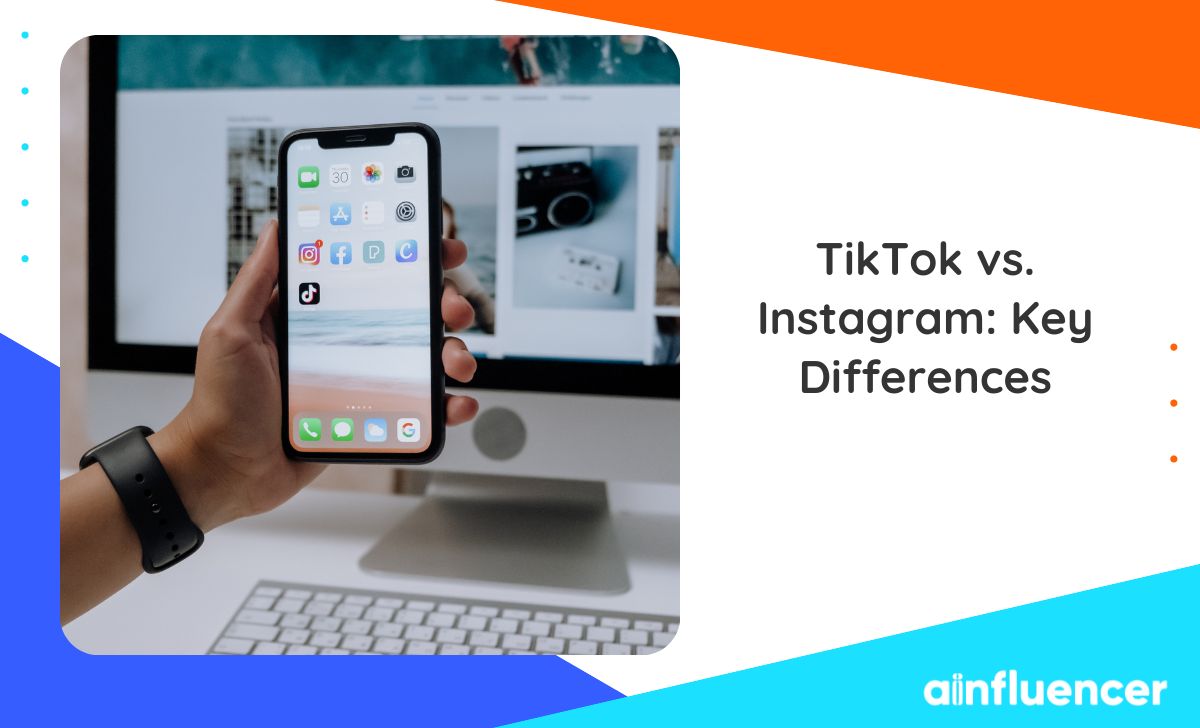
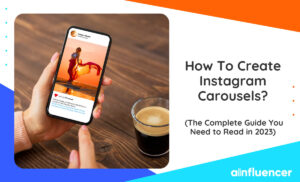
![Read more about the article How To Get 1K Followers On Instagram In 5 Minutes [2024 Hacks]](https://blog.ainfluencer.com/wp-content/uploads/2023/02/How-To-Get-1k-Followers-On-Instagram-In-5-Minutes-1-300x182.png)
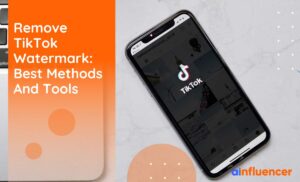
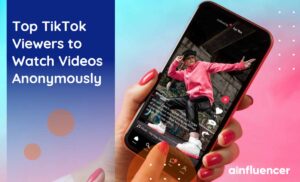
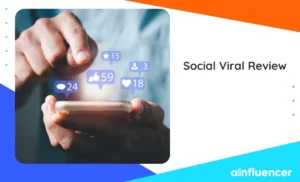

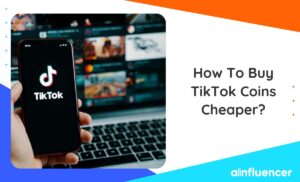
![Read more about the article The Best Time To Post On Instagram [2024 Update]](https://blog.ainfluencer.com/wp-content/uploads/2021/01/The-Best-Time-To-Post-On-Instagram-1-300x182.png)
![Read more about the article How to Go Live on TikTok: The Ultimate Playbook for Creators to Convert Viewers [2024]](https://blog.ainfluencer.com/wp-content/uploads/2024/04/Copy-of-Ainfluencer_Content_Images-300x182.png)